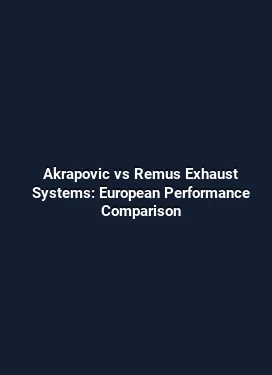Best Cat-Back Exhaust Systems for Toyota GR86 Sound and Performance
For enthusiasts seeking to elevate the driving experience of the Toyota GR86, the cat-back exhaust is a popular and practical upgrade. This system begins just after the factory catalytic converter and extends rearward to the exhaust tips, unlocking a deeper tone, reduced backpressure, and potential horsepower gains when paired with the vehicle’s ECU calibration and other supporting upgrades. When selecting a cat-back exhaust, it is essential to consider sound character, material quality, mandrel bends, fitment, drone behavior, and installation complexity. Below, this guide dives into the best options for the GR86, how they affect performance, and practical considerations to help readers make an informed decision.
Overview of Cat-Back Exhausts for the GR86

The GR86’s engine responds well to exhaust flow improvements, especially when the rest of the exhaust path is optimized. Cat-back systems typically replace the mid-pipe and rear section, offering a balance between weight reduction, improved exhaust gas scavenging, and a more aggressive exhaust note. The ideal cat-back for a daily driver differs from that for a track-focused build, but several universal factors apply: tubing diameter, mandrel bending, resonator or muffler design, and connection type (OEM-style clamp versus full bolt-on). In most cases, a 2.5-inch diameter is a practical starting point for a naturally aspirated GR86, while some setups use 2.75 inches for higher-rev, higher-output applications. The goal is to maximize flow while preserving low-to-mid-range torque for street usability.
Performance gains from a cat-back are highly dependent on the rest of the vehicle’s configuration, including intake, headers, and calibration. While simple bolt-on improvements can yield noticeable gains in sound and throttle response, it is common to see a modest increase in peak horsepower and a more linear power delivery across the RPM range. A well-designed system also reduces exhaust backpressure without creating excessive drone, which can be a source of discomfort for daily driving. When evaluating options, consider how the system balances aggressive tone with highway manners, ensuring a cohesive overall driving experience.
Material and Build Quality: What to Expect
Material quality is a critical differentiator in cat-back exhaust systems. Stainless steel is the standard for durability and corrosion resistance, with 304 stainless steel being the most common choice for premium builds. For enthusiasts seeking lighter weight and a more aggressive aesthetic, 409 stainless or even titanium variants may be available, though these often come at a higher cost. The choice of material affects durability, especially in regions with salting during winter months or coastal environments with salt air exposure.
Inside the exhaust path, mandrel-bent piping maintains a consistent diameter through curves, reducing flow restrictions that can occur with crush-bent tubes. This design preserves exhaust velocity and minimizes turbulence, contributing to a more predictable power curve and a cleaner exhaust note at high RPMs. The muffler design—whether it uses straight-through resonators, chambered designs, or staggered perforated tubes—also shapes the tone. A straight-through design tends to be louder and more aggressive, while chambered configurations can help reduce harshness and drone in the cabin.
Fitment and Installation Considerations

Customer fitment is a practical concern. Reputable cat-back kits are designed to bolt directly to the GR86’s factory hangers and flanges, using standard 2.5-inch or 2.75-inch inlet sizes. Some systems advertise OEM-style clamps for easy removal, which is advantageous for warranty checks or track events where adjustments might be needed. It is important to verify that the system aligns with the GR86’s bumper clearance, as oversized tips can require minor trimming or repositioning. A dedicated fit guide from the manufacturer or a professional installer is worth reviewing to avoid Fitting issues that could affect ground clearance or exhaust routing near underbody components.
Sound Profile: Tones That Suit The GR86
The GR86 benefits from a sound profile that blends sportscar aggression with everyday practicality. A well-chosen cat-back should deliver a deeper, throatier tone at idle and mid-range RPM, with a linear increase in volume as you raise the throttle. Expect a more pronounced exhaust crackle on deceleration in some setups, which can add a motorsport-like character without becoming overwhelming in daily commuting. For those who value a stealthier cabin experience, some systems include resonators that tame drone, keeping the interior sound comfortable at highway speeds while preserving an assertive exterior presence.
Top Cat-Back Exhaust Options for the GR86
When evaluating options, popularity often aligns with a balance of sound, performance, and price. The following categories highlight representative choices that GR86 owners typically consider, spanning mainstream, premium, and performance-taired builds. While prices, weights, and exact sound signatures vary by model year and configuration, these examples illustrate common design approaches and the expectations they set for owners.
Option A: Stainless Steel Mandrel-Bent Performance System – This category emphasizes a robust construction with a straight-through muffler design and a slightly louder, aggressive tone. The piping diameter commonly sits at 2.5 inches, with a tasteful blend of resonance and a crisp top-end presence. The system often includes high-quality hardware and slightly lighter weight than stock, improving throttle response without sacrificing drivability. It’s a go-to for drivers seeking a noticeable but not overwhelming upgrade.
Option B: Tuned Resonator-Equipped System – For drivers who want a balance between performance and comfort, a cat-back with an additional resonator can suppress cabin drone while preserving a sporty exhaust note. This setup tends to offer a more refined sound at cruising speeds and a more linear power delivery. It is a strong choice for daily drivers who also enjoy spirited weekend driving.
Option C: Titanium-Tip, Lightweight Route – Titanium variants prioritize weight reduction and a distinctive metallic sheen at the tail end. These systems are typically lighter and can yield marginal performance gains due to reduced mass, though the biggest advantage is the aggressive look and the possible weight savings. The tuning philosophy often targets a higher-pitched but still authoritative exhaust character, suitable for track enthusiasts who value response and weight savings.
Installation Tips and Common Pitfalls
Installing a cat-back exhaust on the GR86 is generally straightforward for those with basic mechanical skills, but there are important steps to ensure a secure, durable fit. Before beginning, gather the necessary tools: jack stands or a lift, a crankshaft pulley tool if needed, torque wrench, and the correct wrenches for flange and clamp hardware. It is advisable to perform the installation with the vehicle on a lift or properly raised on stands to access underbody mounting points and to verify clearance around heat shielding and suspension components.
During installation, one crucial aspect is ensuring that hangers align with factory mounting points. Some systems use isolating rubber hangers to reduce vibration transfer; if these wear out, replace them with OEM or high-quality aftermarket equivalents to preserve ride quality. After the system is mounted, snug all clamps progressively from front to rear to avoid stressing flanges. It is a good practice to start the engine at low idle and visually inspect for leaks at all joints, then perform a test drive to check for unusual vibrations or drone. A final check after a short drive is recommended to ensure everything remains secure and that there is no contact with frame members or underbody shields.
For those seeking a professional installation, working with a qualified exhaust shop or performance tuner can help optimize fitment and ensure an appropriate balance between the exhaust backpressure and engine calibration. Some GR86 owners coordinate with a tuner to map a mild ECU adjustment that aligns with the new exhaust flow, potentially maximizing gains and tuning a more linear power curve across RPM ranges.
Understanding the practical outcomes of a cat-back upgrade is essential. In real-world scenarios, typical gains from a well-fit cat-back for naturally aspirated GR86 engines are often modest in peak horsepower—usually a few horsepower at the crank—yet the real-world improvements show up as enhanced throttle response, a more rewarding exhaust note, and improved engine breathability at higher RPMs. On track-focused builds or cars running additional performance parts (such as a freer-flowing air intake or headers), the combined enhancements can be more noticeable, especially in the upper RPM ranges where exhaust flow becomes more critical.
Another important consideration is drone management. Many GR86 owners are sensitive to cabin drone at highway speeds. A system with an effective resonator layout or optimized muffler design can dramatically reduce drone while preserving the desired tone. For drivers who frequently commute, this trait is often the deciding factor between two otherwise similar systems. Acknowledging real-world driving conditions—city streets, highway, and weekend canyon runs—helps in selecting a system that aligns with lifestyle and driving preferences.
Maintenance, Warranty, and Longevity
Cat-back exhausts generally do not void factory warranties when properly installed and used within normal operating conditions, but it is essential to review manufacturer terms and local regulations. Stainless steel systems typically offer excellent longevity with minimal maintenance beyond periodic cleaning and inspection for corrosion, especially in winter climates. Routine inspections should check for exhaust hanger wear, heat shield integrity, and any signs of leakage at joints or flanges. For users in coastal areas or where road salt is prevalent, cleaning and frequent checks can extend the life of the system significantly.
Maintenance considerations also extend to hardware quality. Stainless steel clamps and bolts should be corrosion-resistant, and manufacturers that provide high-quality mounting hardware reduce the risk of hardware failure in demanding driving conditions. If a system includes a removable resonator or muffler, ensure that the design permits straightforward serviceability in case replacement or modification is desired in the future.
Choosing the Right Cat-Back: A Quick Decision Guide
To select the best option, start with three questions: how do you use the GR86, what level of sound and drone are acceptable, and what is your budget? For daily drivers who prioritize comfort and a noticeable but not overwhelming sound, a resonator-equipped system with a balanced 2.5-inch to 2.75-inch layout often strikes the best balance. For weekend racers or track enthusiasts, a straight-through design with a lighter weight and a slightly more aggressive tone can deliver the desired edge, particularly when paired with engine and intake upgrades. Finally, for enthusiasts who value weight savings and a distinctive look, titanium-tip options provide a unique blend of aesthetics and performance advantages, albeit at a premium cost.
Before committing, read independent reviews, listen to sound clips from multiple angles, and seek real-world owner feedback for the specific GR86 model year. The nuances between model years, including minor factory tuning changes, can influence perceived tone and fitment, so ensure the chosen system explicitly supports your exact configuration and year.
Maintenance and Care for Your Cat-Back System
Post-install care includes regular visual inspections for rust, loose hardware, and any signs of exhaust leaks. A rinse with water to remove road grime and a periodic coating on stainless surfaces can help maintain the finish. If your climate involves heavy snow or road salt, consider a corrosion protection routine as part of seasonal maintenance. For performance-driven builds, monitoring exhaust gas temperatures with a data logger (where available) can provide insights into how the system interacts with other components under load, guiding future upgrades or calibrations.
Real-World Scenarios: Aligning Upgrades with Goals
Owners who pursue a balanced upgrade path might pair a cat-back exhaust with a high-flow air intake and a lightweight flywheel. This combination can yield a more responsive engine with a perceived increase in torque across the mid-range and a more engaging driving experience. Track-focused builders may opt for a system with minimal backpressure to maximize top-end flow, understanding that this may alter the low-end feel. In such cases, a tune or ECU reflash is commonly used to align fueling and ignition timing with the updated exhaust characteristics, ensuring safe and reliable operation under high-load conditions.
For the daily driver seeking refinement, consider a cat-back option that retains a civilized cabin tone and avoids intrusive exhaust resonance at cruising speeds. This approach often results in a more satisfying, well-rounded package that complements the GR86’s chassis dynamics without compromising everyday usability.
Conclusion: Making an Informed Choice
Choosing the right cat-back exhaust for the Toyota GR86 involves balancing tone, performance, weight, and daily usability. With a clear understanding of material quality, fitment, sound expectations, and maintenance considerations, you can select a system that complements the GR86’s natural characteristics while delivering a satisfying driving experience. The best choice aligns with how you use the car, your tolerance for cabin drone, and your willingness to invest in supporting components or calibration to maximize the full potential of the upgrade.






